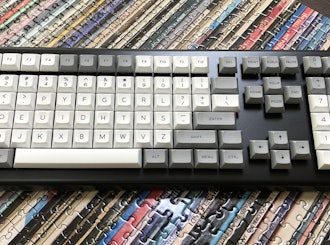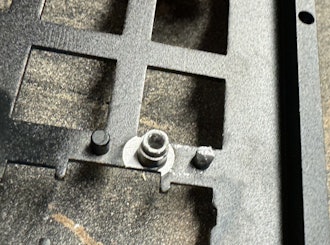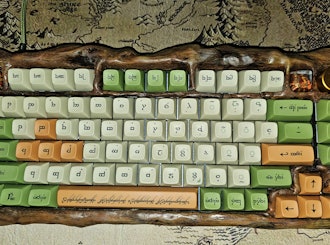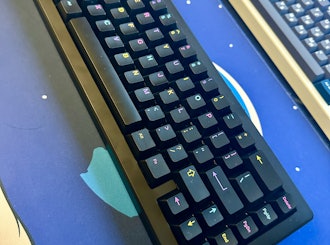Click to view our Accessibility Statement or contact us with accessibility-related questions











The Planck Shift (keyboard idea)
The idea starts with the Planck Light. We take this keyboard with it's low-profile switches and keys and hyper minimalist/slim design. Then, we make changes to the design.
First, we change it from a MIT layout to a grid layout. We don't have an orientation problem because of the color of the keycaps are different on the bottom row and outer left and right columns. Now the thumbs can do their thing as modifier keys (space as well).
Now for the "big idea": changing the key caps: What if each key cap had capacitive touch sensors which can communicate to the board. As you lay your fingers on the home row, this communicates to the QMK firmware that you're in the default layer. Once you shift all four of your fingers up a row entirely (left hand on QWER and right hand on UIOP), then this will change the layer to of the keyboard, enabling an entirely new layer. If you shift down from the home row, (left hand on ZXCV and right hand on M,./), then you enable another layer. By shifting positions of your resting place, you switch layers! This is why it's call the Planck Shift.
The F and J keys should have notches for tactile feedback that your fingers are in the right place for the default layer. As you shift your hands up and down, you're immediately switching modes and you're getting feedback from the feeling of the keys (whether the pointer fingers feel a notch or not) to know whether you're in one mode or another. Modal experiences brake if they require the user to mentally track the mode they're in; UX should provide feedback, whether visual, audial, or tactile.
With this setup, the ability to customize this keyboard really is great. One idea is to have the top layer (shift your fingers up), to act as the number keys. The bottom layer could access a lot of special characters and navigation. What's great is while in the top and bottom layers, the nearby keys from where you're fingers rest can also change; so the keys below the numbers could be a lot of different special symbols (!@#$%^&*(), or even ⁄€‹›fifl‡°·‚).
While in the default layer, the bottom most row is available for the the thumbs to act as modifier keys (ctrl, alt, os, shift) as well as perhaps a space character. When shifting up or down, these could still remain as modifiers for the thumb (most-likely for the up-layer), or non-modifier keys (most likely for the bottom-layer).
In addition to the capacitive touch, the keycaps could also had black/white e-ink displays which could change the letter displayed on the keys as well as the foreground/background color (black background with white foreground, or white background with black foreground). This black/white capacitive keycap design could turn your keyboard into a minimalist, fully customizable keyboard all via software, both functionally and visually!

search
close
Sort by: Newest
keyboard_arrow_downsamholmes
0
Jan 25, 2023
Here's a capacitive sensor with an embedded light: https://www.amazon.com/Heltec-Automation-Capacitance-Capacitive-ColorfulLight/dp/B077SWJ17P/ref=sr_1_6?keywords=capacitive+touch+switch&qid=1674670639&sr=8-6
If e-ink is a challenge, then perhaps having customizable RGB lights could give you the visual feedback instead. Though, it'd be interesting if one could embed a e-ink display instead.
Related Posts

HoffmanMyster
Drop Mech Keys Meetup - May 11th!
It's been a while since we've hosted a meetup at Drop. We want to change that, and are inviting folks to come hang out at our offices (Corsair HQ) in May! The Details Date: Saturday, May 11th Time: 1-5pm Location: Corsair HQ (Milpitas, CA) If you're interested in attending this event (or any future events!), please fill out the google form below. Attendance will need to be capped at roughly 30 attendees given the space (edit: we can accommodate a fair bit more than 30 - only mentioned this to manage expectations as this won't be a mega-event with hundreds; will lean more toward the "intimate" side of things, sub-100). https://forms.gle/3Q8fwCKp4hjkVdv18
Apr 2, 2024

Ike4948
Is there anywhere I can get just the 6.25u stab? I have so many of the other stabs that I would love to have a way to be able to acquire more of the 6.25u without accumulating more of the 2u or 7u that I have just laying around
Apr 22, 2024

Numad1
Checking on this on the 21st of April 2024. Is there an estimated date that pre-orders will be open for this set? No worries if it's still TBD!
Apr 21, 2024
Leimiz
Hi, is it possible to use the case with a different plate? I don't understand if the plate is separated from the case or not.
I use a DZ60 with a HHKB-style layout but with a 3-keys split-spacebar instead of a normal spacebar. I'd want to use the case but obviously the plate wouldn't match if they are made as one unit.
Apr 21, 2024
Trending Posts in Mechanical Keyboards

dvorcol
Support for Alternative Layouts
This is a summary of how alternative layouts have been supported by kits such as Colevrak and Homing. It is not a discussion of alt layout performance and development, but if that interests you I highly recommend starting with Pascal Getreuer’s A guide to alt keyboard layouts (why, how, which one?). It’s a concise and comprehensive overview with links to some great sites that go deeper. He also has a separate Links about keyboards page. The Keyboard layouts doc he recommends explains layout goals and metrics in detail, summarizing the alt layouts discussed here as well as more than one hundred others. Sculpted-profile The majority of custom keycap sets are sculpted-profile (Cherry, SA, MT3, KAT, etc. - more on profiles generally here) so let’s start there. Because each row has a unique keycap shape, alt layouts require a unique keycap for each legend that moves off its QWERTY row. At first there were two The Dvorak layout was patented in 1936 by August Dvorak & William L....
Apr 23, 2024

CousinTimmy
Promo codes for stack Macropad v2
is there any promo codes right now that work with the STACK OVERFLOW THE KEY V2 MACROPAD? link:https://drop.com/buy/stack-overflow-the-key-v2-macropad?searchId=ead314359856d5486d35f4713cff32e9
Apr 23, 2024

Robbedoes
*Help* Screw in stabilizers not fitting in Dropshift V2 keyboard
I'm trying to build a mechanical keyboard with screw in stabilizers, I've build some mechanical keyboards with click-in stabilizers, never with screw in. Somehow one of the pins of the metal top-part collides with the screw in stabilizer of the numpad "enter key". I already tried grinding of a bit of the pin that collides with the stabilizer, but unfortunately I can't make it fit/close properly. You can see that the pin of the toppart leaves a mark on the bottompart of the stabilizer, see picture 2. What am I missing? Using Durock V2 in a Dropshift fullsize V2. See pictures below, thanks in advance!
Apr 23, 2024
Fukyachickennuggets
Polymer clay
Don't drop crazy cash on custom wood builds! Instead go buy polymer clay and paint. Then you can spend a ridiculous amount of time trying to make it look like you can afford to drop crazy cash on...
Apr 22, 2024
GrEEdYY
HELP PLEASE!
HELP PLEASE! I put noise insulation in the keyboard and after that it stopped working, the only sign of life is 5 blinks of orange light.can do something about it? model:DROP ALTv1
Apr 22, 2024

Durazell
Want to build a Clicky Mech Keyboard. Where to begin?
Hello all. Am brand new to the idea of building my own keyboard. Have not a clue where to begin this process. I am a Sim Game enthusiast. American Truck Sim, DCS Flight Sim and goes from there. Need some real help on where to start for making my own Full Size, Clickey Mechanical KB. I want each key to have its own backlighting. Are there keys that are better than others for this? Is there a great spot on site for a person who has never even taken a keyboard apart? Let alone fixed or built one? I would like it to fit my theme of Red and Black. Yet maybe have the option of changing things up a bit. Any help at all would be greatly appreciated. Thank you all kindly, Durazell
Apr 20, 2024






